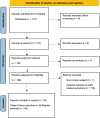Otolaryngological Presentations of Klippel-Feil Syndrome: A Systematic Review
- PMID: 39703307
- PMCID: PMC11656638
- DOI: 10.7759/cureus.73986
Otolaryngological Presentations of Klippel-Feil Syndrome: A Systematic Review
Erratum in
-
Correction: Otolaryngological Presentations of Klippel-Feil Syndrome: A Systematic Review.Cureus. 2025 Sep 26;17(9):c325. doi: 10.7759/cureus.c325. eCollection 2025 Sep. Cureus. 2025. PMID: 41020016 Free PMC article.
Abstract
Klippel-Feil syndrome (KFS) is a rare congenital condition characterized by the fusion of cervical vertebrae. It classically presents with a triad of symptoms: limited cervical range of motion, a low posterior hairline, and a short neck. Common otolaryngological manifestations include hearing loss, dysphagia, cleft palate, jaw disorders, thyroid abnormalities, and ear malformations, highlighting the importance of KFS awareness in the field of otolaryngology. Recognizing these symptoms can enhance patient care and outcomes. This systematic review analyzed all case reports on KFS published in the last 10 years on PubMed. Cases were classified using the Samartzis classification, Mallampati score, and Cormack-Lehane grade. Symptoms were then identified, and common imaging techniques were noted to provide clinical recommendations for treating KFS patients. The study found that more severe vertebral fusions are linked to more serious symptoms. Otolaryngologists should consider KFS in their differential diagnosis, especially in patients presenting with neck masses and pain, hearing loss, dysphagia, scoliosis, Sprengel's deformity, or other musculoskeletal abnormalities.
Keywords: hearing loss; klippel-feil syndrome; otolaryngology; rare genetic disorder; spinal cord fusion.
Copyright © 2024, Stewart et al.
Conflict of interest statement
Conflicts of interest: In compliance with the ICMJE uniform disclosure form, all authors declare the following: Payment/services info: All authors have declared that no financial support was received from any organization for the submitted work. Financial relationships: All authors have declared that they have no financial relationships at present or within the previous three years with any organizations that might have an interest in the submitted work. Other relationships: All authors have declared that there are no other relationships or activities that could appear to have influenced the submitted work.
Figures
References
-
- Klippel-Feil syndrome: clinical features and current understanding of etiology. Tracy MR, Dormans JP, Kusumi K. https://pubmed.ncbi.nlm.nih.gov/15241163/ Clin Orthop Relat Res. 2004:183–190. - PubMed
-
- Approach to neck stiffness in children. [ Jul; 2024 ];Brett-Fleegler M, Teach SJ, Misra SM, Wiley JF. https://www.uptodate.com/contents/approach-to-neck-stiffness-in-children UpToDate. 2023
-
- The Klippel-Feil syndrome: a case report. Lagravère MO, Barriga MI, Valdizán C, Saldarriaga A, Pardo JF, Flores M. https://pubmed.ncbi.nlm.nih.gov/15530267/ J Can Dent Assoc. 2004;70:685–688. - PubMed
Publication types
LinkOut - more resources
Full Text Sources


